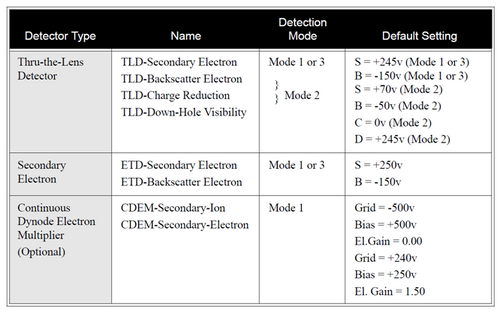LabAdviser/314/Microscopy 314-307/FIB/Helios: Difference between revisions
No edit summary |
No edit summary |
||
| Line 62: | Line 62: | ||
=Equipment performance and process related parameters= | =Equipment performance and process related parameters= | ||
[[File:Helios detector.png|500px]] | [[File:Helios detector.png|500px]] | ||
= Process information = | |||
The following techniques and processes are available on the microscope (list isn't complete): | |||
Techniques: | |||
*[[LabAdviser/314/Technique/EDS|EDS/WDS]] | |||
*[[LabAdviser/314/Technique/EBSD-TKD|EBSD/TKD]] | |||
Processes: | |||
*[[LabAdviser/314/Preparation 314-307/Solid-matter/FIB-lamella|FIB lamella preparation]] | |||
'''Feedback to this page''': '''[mailto:labadviser@nanolab.dtu.dk?Subject=Feed%20back%20from%20page%20http://labadviser.nanolab.dtu.dk/index.php/LabAdviser/314/FIB/Helios click here]''' | '''Feedback to this page''': '''[mailto:labadviser@nanolab.dtu.dk?Subject=Feed%20back%20from%20page%20http://labadviser.nanolab.dtu.dk/index.php/LabAdviser/314/FIB/Helios click here]''' | ||
Revision as of 13:12, 25 March 2020
Dual Beam FEI Helios Nanolab 600
The Dual Beam FEI Helios nanoLab 600 consists of two independent charged particle sources: 1- electrons, 2- gallium ions (Ga+). FEG-SEM with versatile characterization capabilities. At the time being, this microscope SEM provides highest resolution among all operational SEMs at DTU-Cen, when operated for high resolution imaging (i.e. using low kV , in-lens detector, and in immersion mode). This microscope is equipped with the following detectors BSE (backscatter electrons), electron backscatter diffraction (EBSD) (backscatter diffraction pattern), Energy-dispersive X-ray spectroscopy (EDS) (X-Rays), CDEM (secondary ions), etc. Gal+ focused ion beam (FIB) provides the possibility of characterization of microstruture by imaging and serial sectioning via sputtering. Since the microscope is equipped with a micro manipulator for high quality TEM sample preparation. The combination FIB sputtering capabilities, and 2-dimentional imaging and mapping (in case of EDS and EBSD) facilitates 3-dimentional characterization.
Reading Materials
Focused Ion Beam (FIB) File:FIB-Lecture_2011 By Alice.pdf
Gas Injection System (GIS) File:GIS_summary2013 by Alice.pdf
Electron BackScatter Diffraction (EBSD) File:Basic_EBSD-training2014 By Alice.pdf
Transmission Kikuchi Diffraction (TKD) File:TKD_summary_Helios-guide_t-EFSD By Alice.pdf
Quick check list for EBSD measurement: Quick check list for EBSD measurement
Technical Notes
Resolution
- Electron beam: 0.6nm @15kV •0.9nm @1kV
- Ion beam: 4.5 nm @ 30 kV @ 1 pA
Attachments
- Gas Injection System (GIS) for W and Pt both E and I beams. C deposition E beam only. XeF2 and H2O etching Ion beam only.
- OmniProbe for in-situ manipulations
- EBSD system from EDAX-TSL and a Hikari Camera
- EDS detector
To find the basic instructions for operating the instrument, the reader is referred to the labmanager manual.
Important Notes
- ALWAYS make sure the EDS and EBSD detectors are RETRACTED when opening and closing the chamber.
- Do NOT adjust the Nitrogen regulator!!!
- Always open and close the chamber GENTLY whilst viewing the live CCD image.
- Only home the stage with open door or if in vacuum only with holders that you are 100% sure it is safe to do so.
- Make sure you delete all saved positions before finishing your microscope section.
- When moving between saved positions, BE CAREFUL! If you are unsure move the Z height to the lowest point and lock it so as not to collide with the pole piece.
- Use the logbook
- NEVER work without a valid link between the Z and the FWD
- ONLY INSERT EBSD CAMERA if the sample is at the correct position (in case of a special EBSD holder the stage must be tilted to 16 °).
- Always use GLOVES. Only vacuum-ready samples and holders are allowed inside the chamber.
- DO NOT install ANY software on either the microscope or support PC,.
- Transfer your files at the end of each session. We will be deleting files from the support computer without notice.
Who may operate Helios Nanolab 600
Currently, due to the versatile operation modes of the microscope various DTU Nanolab members are co-ordinating activities taking place. Dr. Alice Bastos Fanta is co-ordinating the activities related to EBSD and Adam Fuller is co-ordinating the activities related to FIB.
The rules of who may operate the FEI Helios Nanolab 600 and to what extent they may operate it are:
- Only users who have been trained and approved by DTU Nanolab personnel may operate the instrument. Irregardless of their prior experience any new user with no official DTU Nanolab training or approval cannot operate the instrument, not even under close supervision by experienced users.
- Users may only use the instrument to the extent they have been trained. This means that one should not try to operate the following options/capabilities without explicit training:
- EBSD capability
- EDX capability
Process information
The following techniques and processes are available on the microscope (list isn't complete):
Techniques:
Processes:
Feedback to this page: click here

